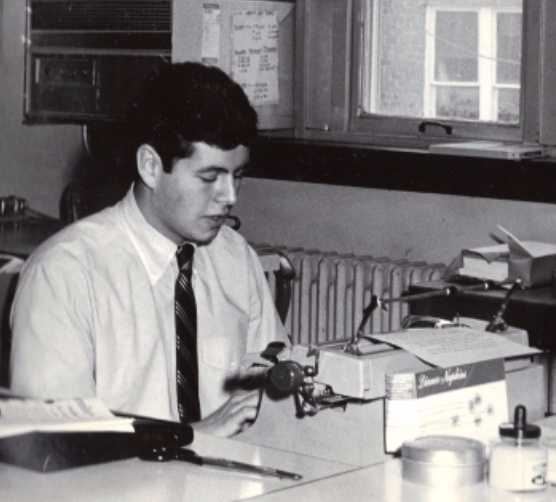
Former Lantern editor-in-chief David Gollust sits at his desk in the Journalism Building in 1968. Credit: Courtesy of David Gollust
Fifty years ago, Lyndon Johnson was president, Woody Hayes coached the Buckeyes, and David Gollust was editor-in-chief of The Lantern.
“It was a time of political turmoil,” Gollust recalled in an interview this month.
In spring 1968, the North Vietnamese Tet Offensive resulted in many casualties in the growingly unpopular Vietnam War. Memphis sanitation workers went on strike for better work conditions as the civil rights movement progressed. Johnson decided against seeking re-election. Martin Luther King Jr. was killed supporting the striking Memphis workers, and Robert Kennedy was killed in California after a presidential campaign rally.
The Painesville, Ohio, native remembers writing the headline –– “Martin Luther King Killed.”
“There wasn’t a lot of time to do a great deal of additional coverage. We wrote a special editorial about it,” he said. “Obviously a huge story because it was a time of anti-war protests and a political awakening of black Americans and black students on campus at Ohio State.”
In parallel to the civil rights movement, there was the looming presence of the Vietnam War.
“Everybody at Ohio State was trying to figure out how to avoid the draft,” Gollust said. The higher the socioeconomic status of a male student, the more likely he would be able to avoid being drafted. “Anti-war protests were a huge background event.”
Gollust described the political awakening many students experienced in the late ‘60s, leading them to become more politically active. He related that awakening to today’s political situation.

Former Editor-in-Chief David Gollust and the 1968 Lantern staff in the newsroom. Credit: Courtesy of David Gollust
“I see an analogy to some extent with the Trump experience, because I think people are registering to vote, running for office, with a lot of the same sense of idealism that characterized 1968,” he said.
“A lot of the same now-oldsters who were all excited about the Kennedy and McCarthy campaigns are now these 70-somethings who are pretty mobilized for the 2018 election.”
Gollust believes The Lantern had a key role in the campus ecosystem of covering the events of that fateful spring.
“There were a lot of very engaging people there on the staff. We had a great time running the paper and pretending –– I was sort of like the publisher. We played campus politics and … we kind of went to war with some of the establishment student types. It was kind of like ‘Animal House.’” He described the paper’s position as “subversive, politically.”
While at Ohio State, Gollust walked into the Associated Press bureau in the Columbus Dispatch building downtown and was offered a full-time job. He went on to work for the Plain Dealer during what he considers a “golden age of journalism,” covering events like the Kent State shootings in 1970. Afterward, he moved to Washington, D.C. to work for the Voice of America as the White House correspondent, and, later, at the State Department in the same role. His career took him to 90 countries.
After his long journalistic career and changes in his profession and politics, he recognizes the obstacles journalists now face.
“I’ve never seen this level of disparagement of the news media … the rise of the internet and people going to various sites, and disreputable people setting up websites like Breitbart and InfoWars –– everybody can get on the internet now and reinforce their own biases,” he said.
As for what glimpse the events of 1968 might give us into the future, he reflected, “Whether we are headed for some kind of colossal disappointment, the imagination can only run wild. We have this 2018 congressional election, which looks like perhaps the most important U.S. election since 1968.”


